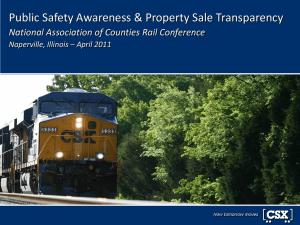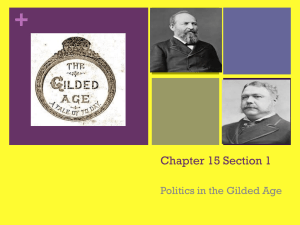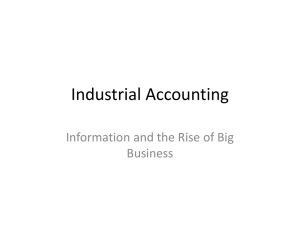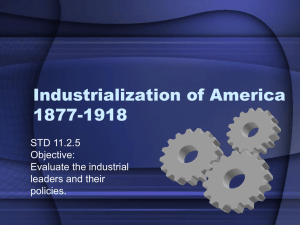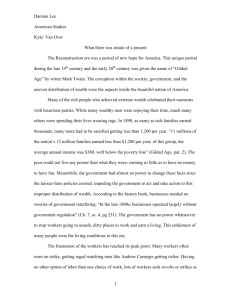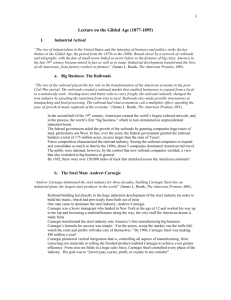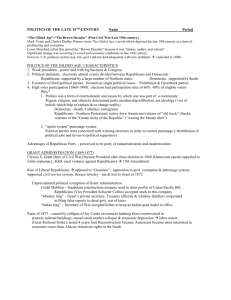Period 6 Review Terms: Gilded Age- During the late 19th century
advertisement
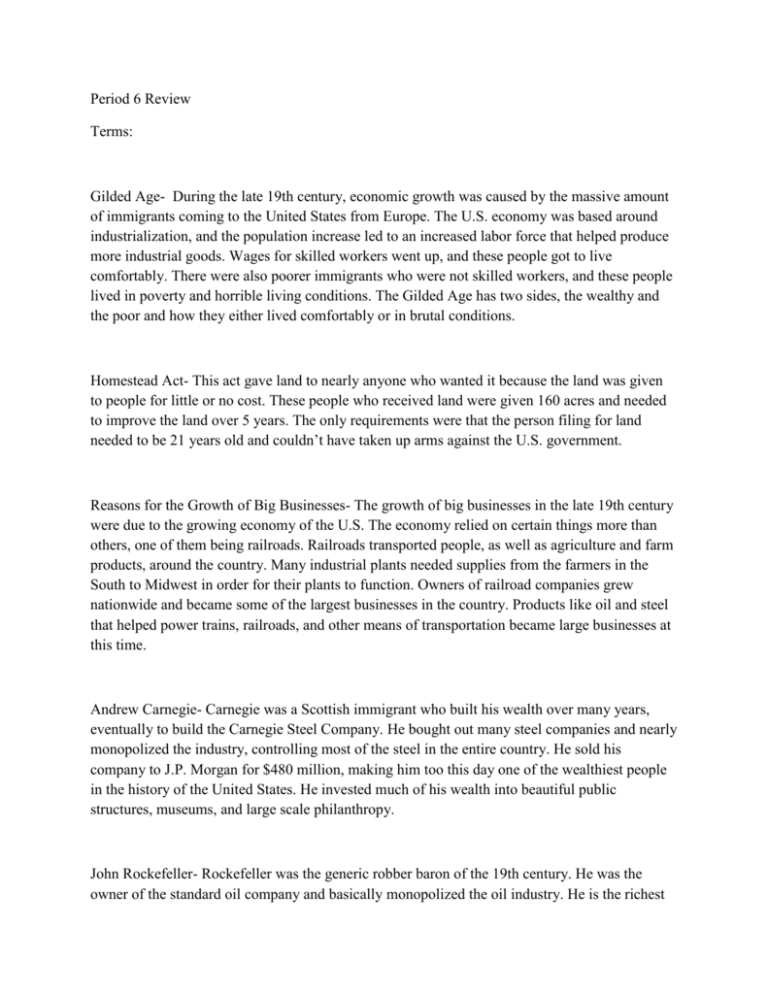
Period 6 Review Terms: Gilded Age- During the late 19th century, economic growth was caused by the massive amount of immigrants coming to the United States from Europe. The U.S. economy was based around industrialization, and the population increase led to an increased labor force that helped produce more industrial goods. Wages for skilled workers went up, and these people got to live comfortably. There were also poorer immigrants who were not skilled workers, and these people lived in poverty and horrible living conditions. The Gilded Age has two sides, the wealthy and the poor and how they either lived comfortably or in brutal conditions. Homestead Act- This act gave land to nearly anyone who wanted it because the land was given to people for little or no cost. These people who received land were given 160 acres and needed to improve the land over 5 years. The only requirements were that the person filing for land needed to be 21 years old and couldn’t have taken up arms against the U.S. government. Reasons for the Growth of Big Businesses- The growth of big businesses in the late 19th century were due to the growing economy of the U.S. The economy relied on certain things more than others, one of them being railroads. Railroads transported people, as well as agriculture and farm products, around the country. Many industrial plants needed supplies from the farmers in the South to Midwest in order for their plants to function. Owners of railroad companies grew nationwide and became some of the largest businesses in the country. Products like oil and steel that helped power trains, railroads, and other means of transportation became large businesses at this time. Andrew Carnegie- Carnegie was a Scottish immigrant who built his wealth over many years, eventually to build the Carnegie Steel Company. He bought out many steel companies and nearly monopolized the industry, controlling most of the steel in the entire country. He sold his company to J.P. Morgan for $480 million, making him too this day one of the wealthiest people in the history of the United States. He invested much of his wealth into beautiful public structures, museums, and large scale philanthropy. John Rockefeller- Rockefeller was the generic robber baron of the 19th century. He was the owner of the standard oil company and basically monopolized the oil industry. He is the richest man to ever live and was a ruthless businessman who would eliminate competition without hesitation. He was a human representation of the gospel of wealth which basically made it seem okay to take advantage of other people in the pursuit of wealth. Laissez-Faire capitalism-theory/reality- Laissez-Faire was the idea of a free market economy where everyone had equal opportunity to be successful and make a living for themselves. Government would keep their hands off and do very little to regulate the economy. The reality was that the government did in fact keep their hands off (most of the time) but what was a lie was that not everyone would get the same opportunity because their were captains of industry who would monopolize sections of the economy and make it impossible for smaller businesses to profit. Social Darwinism- the basic idea of "Social Darwinism" was "survival of the fittest". This applied to America in this time period because the economy was basically survival of the fittest. The strongest would make the most money in the economy and the weakest, smallest businesses would die off or go out of business. Gospel of Wealth- the gospel of wealth promotes the idea of social Darwinism and gave the robber barons of the 19th century America an excuse to perform savage acts in the free market economy by putting smaller businesses out of business and testing people and laborers awfully in order to benefit financially. The gospel of wealth was also an essay written by Andrew Carnegie to promote philanthropy by the upper class Sherman Antitrust Act of 1890- This was a law passed by the government to regulate businesses and make prohibit monopolizing certain industries in the economy. This was put into place so people like John Rockefeller and Andrew Carnegie wouldn’t gain overwhelming power. Panics/Depressions- America went through difficult economic times in the 1870’s, but they paled in comparison to the Depression of 1893. At this time, the railroad companies collapsed, causing the economy to remain stagnant. This impact of this was tremendous as banks closed, railroad companies were forced into bankruptcy, and unemployment reached 25 percent. City Life (Improvements/Problems)- In the later part of the 19th century, the U.S experienced great urban development. This brought forth some positive and negative trends. For example, in terms of transportation, electric trolley cars were very efficient, eliminating waste. However, congestion resulted in unsafe conditions as 600 people were killed each year by Chicago trains. Furthermore, urban developments yielded magnificent architectural designs. Although very positive and pleasing to the eye, many men had to work from great heights which was very hazardous. American Federation of Labor- This union of laborers reached over a million followers at its peak, and had much more success than other union groups such as the Knights of Labor. This is probably because the AFL didn’t accept immigrants and unskilled workers as this was detrimental to their plan. They simply bargained for better wages and working conditions whereas the Knights of Labor had very high, unrealistic goals. Knights of Labor-labor union founded in 1869 that included skilled and unskilled workers irrespective of race or gender. This is significant because it included both skilled and unskilled workers, providing a larger amount of support. It is also important because it was a group that could help workers get better working conditions like shorter hours and higher wages. Pullman Strike-a railroad strike, stemming from wage cuts and long hours, that became very violent and spread cross country. This was important because it was widespread and gave the threat of the middle class rising up. It also shows the extreme that strikes went to because of the violence that occurred. Frederick Jackson Turner-came up with the Turner Thesis. This thesis states that American democracy is based on the American frontier and expansion of America. This is significant because it explains why America is different from European countries and created talk among Americans on whether this was the high point of American history or not. Indian Wars-wars between Indian tribes and Americans over Indian rights and land. These wars were significant because it shows that during expansion, Americans were willing to kill innocent people and break treaties in order to gain land. Dawes Severalty Act- allowed the president to survey Indian land and divide it into individual ownerships. Tribal ownership of land was beginning to be eliminated because the act allowed “excess land” to be purchased; it was thought that the Indians did not need it and the leftover land was sold to the government in order to civilize Native Americans. William Jennings Bryan- ran for president in 1896, 1900, and 1908. He was under the Democratic Party and supported the silver standard. His goal of “free silver” won him the support of the Populist Party as well but he never won a presidential election. “Cross of Gold” speech- a speech given by William Jennings Bryan which showed his support of bimetallism (Use of two metals, usually gold and silver, at a fixed relative value as monetary standard) Bryan spoke of the gold standard as a burden and disagreed with Republicans on the idea of eliminating silver coinage and adopt a strict gold standard Plessy v. Ferguson- A Supreme Court case regarding the Jim crow railroad cars that were segregated. The court decided legislation could not overcome racial attitudes and having “separate but equal” facilities for blacks and whites were constitutional. Segregation was valid. Questions: 1. How did the frontier act as a “safety valve” for Americans after the Civil War? The frontier of the United States gave Americans something to excite and fantasize about after a very violent Civil War. Stories and plays of the Wild West attracted many people and took their minds off the war. The west also attracted many people trying to start a new life, and knowing there was a lot of open land westward, many people wanted their own piece of land they could call their own. The west offered opportunity and excitement to many people who haven’t felt great because of the Civil War. 2. How did farms in the 1880s and 1890s begin to resemble factories? As factories used new machinery and developed new technology to mass produce products, farmers used new innovations and machinery to help grow more crops and make farming easier for farmers. Inventions like the steel plow created by John Deere made plowing land easier and faster than ever before. 3. How did American Indian policy from 1865-1900 complete a century of dishonor toward Native Americans? There was little to no legislation passed benefitting the native Americans during this time. So that's why this time is considered to be apart of the century of dishonor which was known because of the Injustices made to Native Americans during US expansion and assimilation of them. 4.) How were trusts both a blessing and a curse for America? Trusts were good for the nation because they made the economy grow and created new jobs. They were bad for the nation because they messed with the idea of free competition in the market 5) Were the industrialists of the Gilded Age robber barons or creative entrepreneurs? This “Gilded Age” can be looked at through two perspectives. One could view this period as a time of despair and great poverty. The large majority of people had to work long, hard hours in many times unsafe conditions. The “Captains of Industry” such as Rockefeller, Carnegie, and Gould were ruthless in this sense. There were also some who lived in the slums or tenement houses. Four families had to cram into one floor at times. There was widespread poverty, and the government was often unsupportive. On the contrary, one could say this period was just a product of Social Darwinism and truly epitomized what America was all about. It is an arguable point to say that a few men made the most out of a really good situation. 6) Why were the railroads the first industry to face government regulation? Farmers out west were getting restless towards railroad companies in the 1880’s. Railroad companies had a lot of economic leverage considering their service was essential to the success of others. This caused the government to step in and form the Interstate Commerce Commission, which was an agency to help regulate a fair economy and make sure the railroad companies didn’t obtain too much power. In other words, the railroad companies abused their economic power by setting rates too high for the average farmer. This caused the federal government to intervene. 7. How was the nativism of the 1890s a continuation of past attitudes in America? Whites have always seen themselves as better than the Native Americans. They saw the Native Americans as savages with land and resources that they wanted. In the 1890s, there was land that Americans wanted and they were willing to do anything they could to get including to kill. Americans continued to use excuses to justify the unjust things they were doing to the Native Americans, like it was their Christian duty to civilize the savages. The nativism was a continuation because of the goals and justifications Americans used with Native Americans. 8. How did Plessy v. Ferguson validate and perpetuate the Jim Crow system? Plessy v. Ferguson validated the Jim Crow system by making anti-black laws constitutional. It allowed the idea of “separate but equal” to triumph. This not only made African Americans second class citizens, but it caused segregation to increase. More public places began to enforce “separate but equal,” ultimately creating more anti-black sentiment. Whites, especially in the South, were able to apply “white supremacy” to their daily lives, further oppressing blacks. 9. In what ways were Populists ahead of their time? The People`s Party held the Populist platform in which they conducted realistic ideas for society such as states laws enacted by voters, senators being elected based on popular direct vote or eight hour work day. Their ideas were not in use immediately but in eventually were put into place. To many this party represented the common man and the Populist Party`s ideas for change within the nation seemed to be more advanced than those of Republicans or even Democrats. 10. How was the election of 1896 a turning point in America's politics? this election followed the economic depression of 1893. Democrats had William Jennings Bryan who gave the Cross of Gold speech because Democrats favored the unlimited coinage of silver. These ideas seem to mix with those of the Populists. Republicans had William McKinley who was a friend of labor. The republicans supported a high protective tariff and upheld the gold standard as a opposed to the unlimited coinage of silver. The election marked the end of a stalemate of American Politics from the Gilded Age, the end of the free- silver movement and the Republican party was now one of business, industry, and a strong national government. The Populist Party declined


